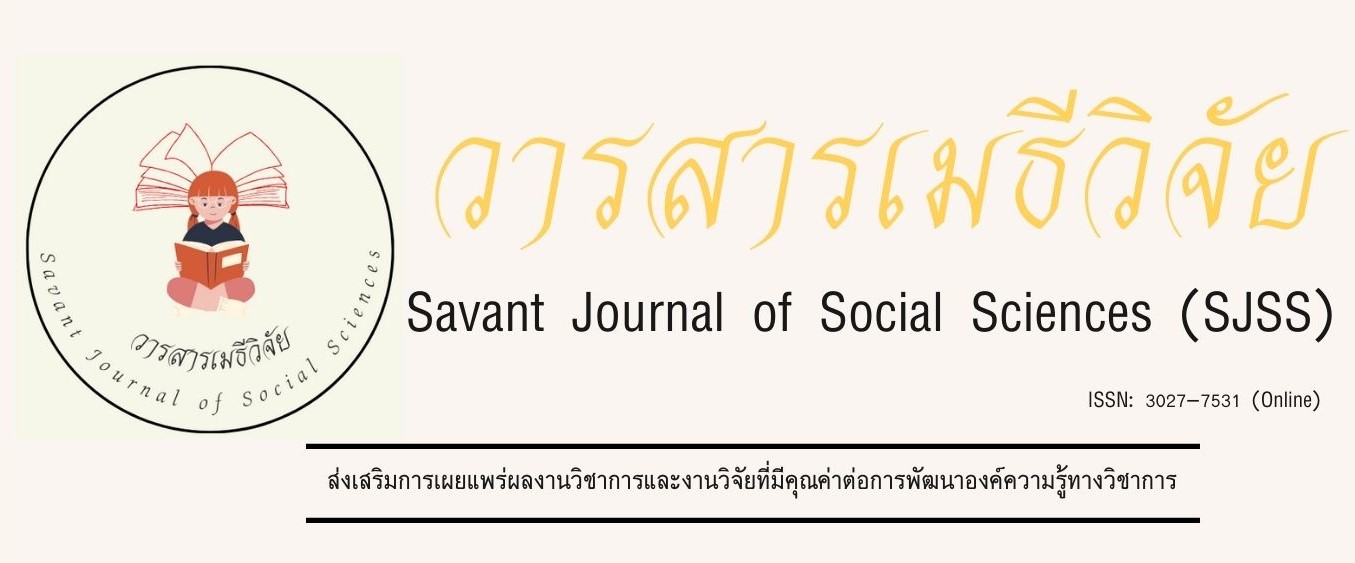a study of the relationship between the 18 elements of the paticcasamuppada in the development of vipassana meditation
Keywords:
Paticcasamuppada, Element 18, Practicing vipassana meditationAbstract
This research aims to study Paticcasamuppada and the 18 elements in the Buddhist scriptures, study Relationship of Paticcasamuppada with the 18 elements in Vipassana practice, and analyze the factors and balance of Paticcasamuppada and the 18 elements in Buddhist scriptures. Use the document research format (Document Research) using primary data from the Tipiṭaka. Descriptive data analysis The research found that Paticcasamuppada is important and beneficial to those who want to achieve or escape from the cycle of birth and death, physical suffering, mental suffering, and fear. All of these things will have things that will help. is Immortality It is a Dhamma that has been in place for a long time. Lord Buddha came to meet Consider leaving suffering. By performing it for intelligent beings to be freed. As for the word element, it is something that already exists and is firmly established. The 18 elements in Buddhism. In summary, it means that things already exist: eyes, sight, ears, hearing, nose, smell, tongue, taste perception, body, physical contact, mind, mental contact.
Relationship of Paticcasamuppada with the 18 elements and methods of practice Paticcasamuppada is called Dhamma that depends on each other's emergence when we consider the causes of relationships arising from different conditions of seeing, hearing, smelling, tasting. Physically aware of cold, hot, soft, hard until it becomes mental perception. As for the word 18 elements, it is the perception and consideration of things that exist when the eyes, ears, nose, tongue, body and mind are things that exist in the body. The elements are the same, there are the receiving elements, the affecting elements, and the knowing elements: the eye sees form, the ear hears sound, the nose smells, the tongue senses taste, the body perceives objects, the mind perceives form, sound, smell, taste, all possibilities in living things, and the elements. Chayatā is the existence of this as a factor and the condition, the symptom that arises according to the factor. Both causes are causes and consequences that must be related. Paticcasamuppada has two paths: the path that creates suffering (samudhayavāra) and the path that terminates suffering (nirodhavāra). Therefore, the factors related to the 18 elements are the natural laws governing all things in the universe. There is orderliness. And there are definite rules. It is a definite cause and effect.
References
บรรจบ บรรณรุจิ. “ปฏิจจสมุปบาท : ขั้นตอนการรู้แจ้งความจริงของพระพุทธเจ้า และการปรับใช้เพื่อแก้ปัญหาสังคม”. บทความวิชาการ. วารสาร มจร บาฬีศึกษาพุทธโฆสปริทรรศน์. ปีที่ 4 ฉบับที่ 1 (มกราคม - มิถุนายน 2561).
พระโกษา อินฺทปญฺโญ (นิติศร). ศึกษาธาตุ 5 กับการเจริญวิปัสสนาภาวนาในคัมภีร์พุทธศาสนาเถรวาท. วารสารปรัชญาปริทรรศน์. ปีที่ 24 ฉบับที่ 1 (มกราคม - มิถุนายน พ.ศ. 2562).
พระจาตุรงค์ ชูศรี. การเข้าใจชีวิตบนพื้นฐานแนวคิดเรื่องธาตุ 18. บทความวิชาการ. วารสารพุทธมัคค์ศูนย์วิจัยธรรมศึกษา สำนักเรียนวัดอาวุธวิกสิตาราม. ปีที่ 2 ฉบับที่ 2 (กรกฎาคม-ธันวาคม 2560).
พระพรหมคุณาภรณ์ (ป.อ.ปยุตฺโต). ความเป็นอนิจจังของสังขาร กับอิสรภาพของสังคม. พิมพ์ครั้งที่ 2. กันยายน 2552.
พระมหาธีรภัทร์ ชินอตฺตโน (วิลัยรัตน์). ศึกษาหลักธรรมและวิธีการปฏิบัติวิปัสสนาภาวนาในอทันตอคุตตสูตร. พุทธศาสตรมหาบัณฑิต. สาขาวิปัสสนาภาวนา. บัณฑิตวิทยาลัย: มหาวิทยาลัยมหาจุฬาลงกรณราชวิทยาลัย, 2560.
พระอธิการทันจิต คุณธมฺโม. ศึกษาหลักการกำหนดรู้ธาตุ 18 เป็นอารมณ์ ในการปฏิบัติวิปัสสนาภาวนา. พุทธศาสตรมหาบัณฑิต. สาขาวิปัสสนาภาวนา. บัณฑิตวิทยาลัย: มหาวิทยาลัยมหาจุฬาลงกรณราชวิทยาลัย, 2562.
พุทธทาสภิกขุ. ปฏิจจสมุปบาทจากพระโอษฐ์. กรุงเทพมหานคร: ธรรมทานมูลนิธิ, 2521.
มหาจุฬาลงกรณราชวิทยาลัย. พระไตรปิฎกภาษาไทย. ฉบับมหาจุฬาลงกรณราชวิทยาลัย. กรุงเทพมหานคร: โรงพิมพ์มหาจุฬาลงกรณราชวิทยาลัย, 2539.
นภากร ศรีสม. (2567). การจัดการศึกษาทางพระพุทธศาสนาเพื่อเสริมสร้างสันติภาพ. บทความวิชาการ. วารสารเมธีวิจัย, ปีที่ 1 ฉบับที่ 3 (พฤษภาคม –มิถุนายน).






